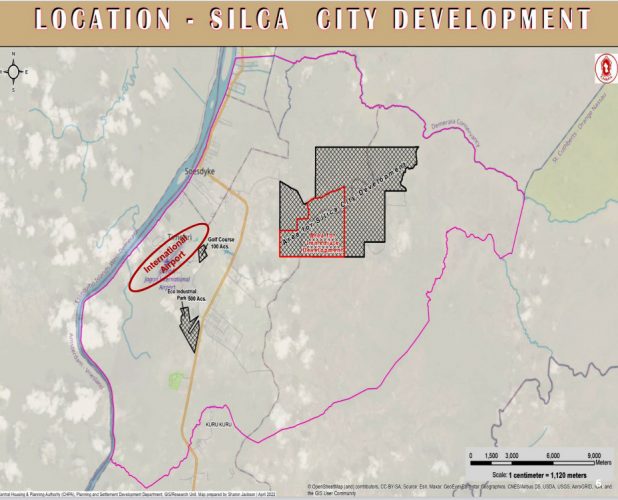With its development guided by the Sustainable Development Goal (SDG) of sustainable cities and communities, the government’s planned Silica City is envisioned to be a transformational solution to address climate change impacts, such as flooding from rising sea levels and complement the country’s rapid growth.
Silica City, a vision of President Irfaan Ali when he functioned as Minister of Housing and Water, is being touted as the Caribbean’s first smart and innovative city. The development of the city is projected to cost $81.7 billion. The cost includes consultancy services, identification, feasibility studies, and execution of the urban project proposals.
Of the $81.7 billion, $39.6 billion will be spent on integral infrastructure, such as lighting, road network development, construction of drainage and culverts, sidewalks, water supply, electricity networks and land preparation.

“Silica City is about a modern low-carbon development path that is compatible with Guyana’s commitment at CoP 26 (United Nationals Climate Change Conference 2021). Silica and Guyana’s understanding that a new modern SMART City is required given its geographic location and the rapid economic development that Guyana is witnessing,” Minister within the Ministry of Housing and Water Susan Rodrigues said during the opening of the recently held International Building Expo.
Rodrigues posited that the development of Silica City represents the transformational change that will bring life to Guyana’s low-carbon development pathway.
“Its design is guided by the SDGs, the New Urban Agenda (NUA), the city beautiful movement, the national multi-hazard disaster preparedness and response plan, and by the Housing Act 36:20, among other elements. Silica city will have beautifully aesthetic building designs, and most of all, the creation of a modern, new, smart city that will create the nurturing of lifestyles that balance culture, climate change risks, and economic vitality,” Rodrigues explained as she provided a brief insight into the vision.
Under its conceptualisation, principles such as zero carbon footprint, net zero waste, construction materials from renewable sources, smart meters, smart grids and diversity in the energy mix, affordable homes, public transit systems, healthy living and community spaces will be incorporated to achieve the objective of the city.
The developers are considering the use of a solar and natural gas energy mix for the city. The solar energy farm will be strategically positioned as solar trees within an industrial park.
In its planning methodology, works will commence in the Greenfield development phase, which includes land clearing and preparation. Works will then transition into settlement upgrades, presenting the opportunity for improvements and infrastructure to existing settlements. After this, works will commence on the development management through the planning permission system. This phase is where the authorities will overlook the location and positioning of new development projects on private lands.
Of the 12,100 acres of land, 2,146 acres, the largest land allocation in the development will be for residential purposes. It will also include a commercial area, an industrial zone, a tourism district, a conservation district, an agriculture zone, a hydroponic area, administrative and sports districts, among other areas for use.
Currently, the Central Housing and Planning Authority (CH&PA) is the agency in the ministry which is the developer and it is working along with the Guyana Lands and Survey Commission to acquire the necessary land. The agency is also moving towards the design and development of phase one of the housing development, which is the residential zone of the city.
Simultaneously, the agency is working to finalise the urban design brief, which will provide information to interested investors and finalise the urban plan.
They are also engaged in stakeholder consultations with the utility companies and sister agencies to garner necessary information on their requirements in the city.
Phase one of the development includes consultancy services and 3-D modelling and visualisation of the urban development master plan. Some US$1 million is being spent in this phase.
The Ministry of Housing and Water during a presentation to the Saudi Arabia delegation here earlier this month provided a briefing on the development. This was done in a bid to attract investors to play a part in the development of the new city.
According to the presentation, the government will actively work and have infrastructure work undertaken to develop the necessary lands. The planning period is projected to last up to 2042.
It was explained that during the first five years, the city will be developed to cater for approximately 12,000 persons, an equivalent of 3000 households. In that period, the city will cater to the needs of 50,000 persons with light employment and accommodate new households of approximately 12,500.
From the presentation, which this newspaper has been privy to, the design of the residential area will be low density and low impact to accommodate a variety of plot sizes and housing types. It will contain supporting neighbourhood hubs vital for community services and facilities.
Meanwhile, the non-residential areas will feature high-end central business districts that will amplify commerce, entertainment, and technology. This will be boosted by vibrant aesthetic streetscapes and a unique public realm with cultural and recreational spaces.
Over the next year, the executing agency is aiming to commence work on initiatives, such as a golf course resort facility, as well as an eco-industrial park and town centre along with phase one of the housing development.
In the presentation, it was outlined that the golf course facility will be a pristine outdoor recreational facility equipped with a nine-hole golf course, clubhouse, hotel and recreational facility.
An overview of the eco-industrial park will see an agglomeration of industries that can benefit from operational and marketing linkages and integration of the industrial park with a wider transport network.
It was stated that a regime of incentives will be offered to attract potential investors to the area.
In the plan for accessible transport, it was stated that there will be a multi-modal road network to accommodate all forms of transit and pedestrian type of transport. The city will be outfitted with a sustainable road network design with a clear hierarchy of roads. It will include street trams as a means of reducing carbon emissions. There will also be a by-pass and automated terminal facility for internal transit efficiency and connection between sites.
Within the city, there will be an innovation centre and ICT hubs, along with applied smart technology where QR code signage will be placed around the city to facilitate easy navigation.
QR Codes will also be generated for persons visiting the conservation district to function as tour guides by virtually sharing information about the flora and fauna species found in the district.
From the presentation, it has been established that the Conservation District will be integrated into the open space strategy for Silica City. It will provide opportunities for educational, scientific, and recreational purposes.
Riparian buffers will be constructed around each waterway as an added measure of protection to the area, which is planned to be kept in its natural state as far as possible. However, there will be spaces that will be converted into walkways and cycle paths.
Meanwhile, the tourism district will be a highly attractive spatial designed space encouraging new forms of tourism recreation. The vision of the area is to stimulate vibrancy and socio-economic growth among nearby zones.
As it relates to agricultural lands, from the presentation it was highlighted that there will be the utilisation of urban agriculture techniques, such as hydroponics. Various plots of land will be identified for different agricultural ventures. In regards to traditional farming systems, innovative drainage and irrigation features will be looked at.
Moreover, the developers are aiming to include a sustainable urban drainage system to provide efficient stormwater management throughout the entire city.
The drainage system will mainly function as a counteractive measure to flooding and capture stormwater runoff into designated retention areas.
It will also create unique aesthetics that reflect the multi-functional elements of all defined open spaces and enhance recreation opportunities such as elevated water trails and walkways.
Under the waste management plan, the developers are considering a modern sewerage system that will be geared toward effective waste disposal processes, specifically recycling and modern wastewater treatment facilities.
It was pointed out that an environmentally friendly system must be considered given the sensitivity of both soil and hydrology of the land.
On the eve of Guyana’s 55th Independence Anniversary, President Irfaan Ali reiterated his government’s plans for a new city further inland.
“We need to build new communities further inland to spread our population; reduce prices for land and housing and cease traffic congestion. We must use the land space, with which we have been blessed, to create new and improved living conditions new areas of growth and development and new population centres.”
Ali said that his government will establish a new city and incentivise the private sector as well as persons wishing to own their own homes to locate to this new hub with major facilities provided by the central government.
In 2013, Ali, then Minister of Housing, announced during the fourth annual building and construction exposition that Silica City would be located amid 500 acres of land to be developed for housing along the Linden/ Soesdyke highway.
“This is an exciting time with exciting prospects… every person has real economic opportunities to grow and develop. Dream big your government will support those dreams,” he had declared.






